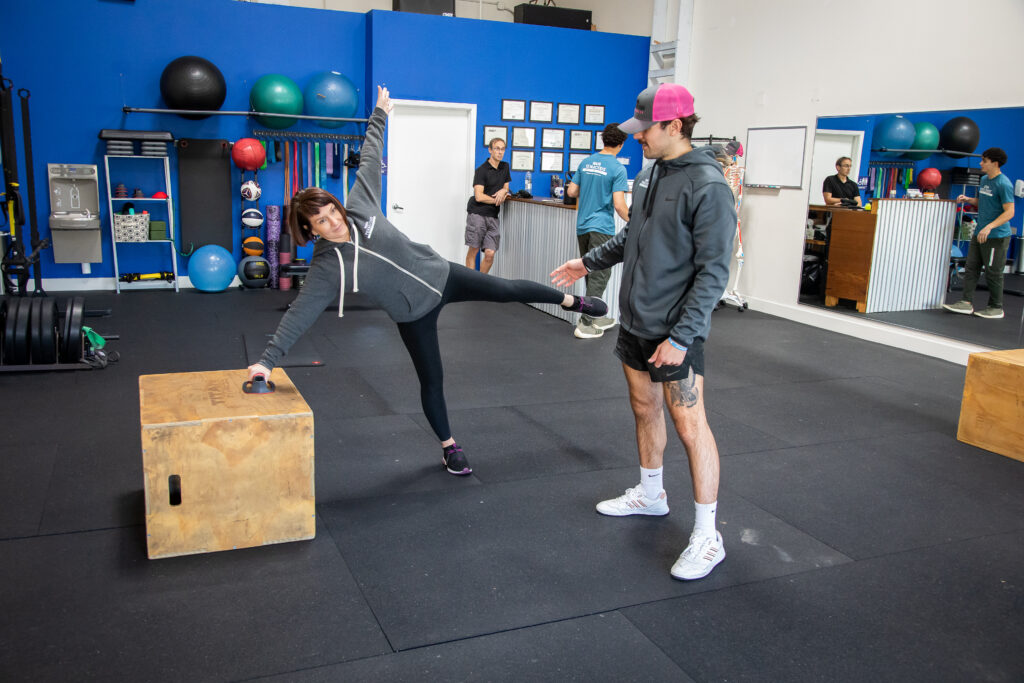Have you ever felt a little imbalanced first thing in the morning? For instance, bending down to put your socks on followed by tying your shoe laces might be a little slower than normal, traversing a set of stairs might seem like your body is shifting more lateral than usual, or bending down to retrieve Tupperware out of the bottom drawer in the kitchen causes a shift in equilibrium. Could these presentations of imbalance be caused by the advancement of age, a deficit in critically important nutrition factors such as inadequate hydration or suboptimal food choices, or the deconditioning of connective tissues throughout the body?
Perhaps we could examine challenges in everyday balance through the lens that our bodies become imbalanced due to a combination of factors caused by aging, suboptimal health choices, or previous and current injuries. We can also view balance-based regressions as a helpful reminder to address our imbalances. If we want to improve our everyday functional performance by reinforcing our balance, purposefully addressing areas of imbalance, and setting attainable goals to enhance proprioception, coordination, and overall everyday human performance, we have the potential to positively influence optimal balance for everyday life activities in the long run.
Setting our standards to the athletic performance of Mikhail Baryshnikov, Natalie Portman’s role in Black Swan, or Simone Biles’ gold medal Olympic feats might be a lofty goal to meet. It’s worthwhile to appreciate and admire these athletic accomplishments of humanity. However, less than one percent of the world’s population can even begin to think about replicating the movements of the world’s most athletic people. For everyone else, setting a standard of always maintaining optimal balance should be more than just avoiding falls. Continuous practice to reinforce balance via a combination of strength, flexibility, and mobility training can help us with normal activities we perform everyday, like getting in and out of the shower, walking up curbs, or interacting with our grandkids or peers that are ten to thirty years younger than us that join us in recreational physical activities.
Injury prevention, balance, and coordination are among the most important themes we focus on for our personal training clients’ goals throughout their fitness journey when designing their exercise prescriptions. If an injury occurs, work can’t be done to improve components of a person’s health and fitness. Ensuring exercises are conducted safely, while also being aware of potential risk factors, is critically important. Being proactive and addressing potential “what could happen” events during exercise helps reduce the likelihood of exercise-induced injuries. This becomes increasingly apparent when practicing balance-based exercises. Instructing a person to stand on one leg for a few seconds when they haven’t been in that position for years can pose a risky situation. First things first, ensure your safety and understand the potential mechanisms of injury that can occur when participating in balance improvement-themed exercises.
Next, we focus on progressions in balance. To discover how to improve balance, testing balance is crucial in determining a person’s level of balance. Discovering the point A to get to point B should never be left untouched. For example, a basic test is the isometric split stance test. To perform, start with both feet placed perfectly underneath the hips. Then take one step forward and stay in that stance for ten to fifteen seconds. Test on both legs. If the position can be maintained on both legs, give yourself a pat on the back and progress to another appropriate balance test.
A suitable progression from the isometric split stance is to narrow the stance width. From the previously described split stance, move the lead foot slightly toward the midline of the body, thereby narrowing the stance. This position narrows the body’s center of gravity. Applying a compromised position away from what a person comfortably considers a normal stance introduces the demand to require more focus and muscular engagement to ensure the body doesn’t deviate laterally and maintain an upright position. If this position can be maintained for ten to fifteen seconds without wobbling and requiring the feet to be moved to address the imbalance, progressing to a more advanced balance exercise might be appropriate.
Further progressions in balance-based exercises include heel-to-toe walks, lifting one foot and standing on one leg for an extended period, or stepping up and over objects for repetitions. While all of these tactics are useful and apply invaluable assets to fitness, strength, and overall human performance in everyday life, understanding one’s current state of balance and identifying one’s imbalances can’t be overstated. Before venturing into balance-based exercises, test yourself out first. If needed, find a trustworthy fitness professional, physical therapist, or physician who can offer a safe and effective balance test. After a foundation has been established, a scalable, safe, and effective strength and conditioning plan can be developed to make progress in balance for everyday life activities.

Sean McCawley, the founder and owner of Napa Tenacious Fitness in Napa, CA, welcomes questions and comments. Reach him at 707-287-2727, napatenacious@gmail.com, or visit the website napatenaciousfitness.com.
